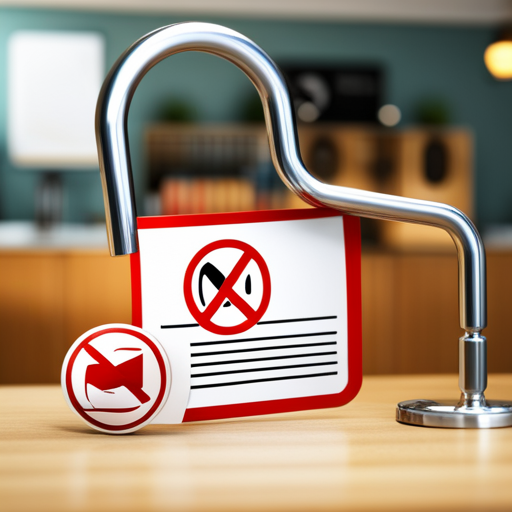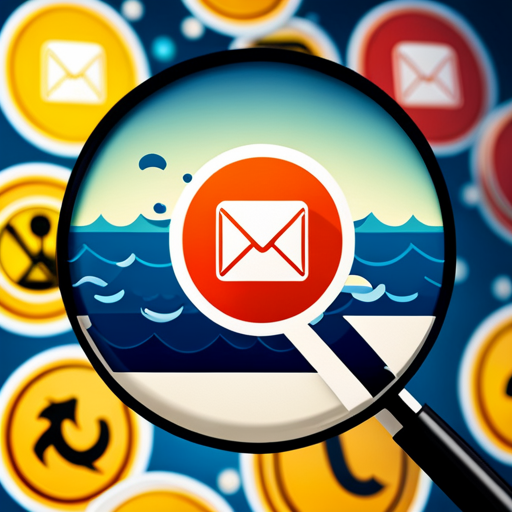Phishing attacks have become increasingly prevalent and sophisticated in the digital age, posing a significant threat to personal and sensitive information security. These attacks often take the form of deceptive emails, where attackers impersonate reputable organizations or individuals to gain access to the victim’s financial accounts, passwords, or other valuable data. As a result, email users need to develop the ability to recognize and avoid such threats in order to protect themselves from potential harm.
This article aims to educate email users about the various red flags that are indicative of phishing attempts and provide guidance on how to stay vigilant against these malicious attacks. By understanding the key warning signs, such as suspicious email addresses, domain names, and the presence of unsolicited attachments or links, individuals will be better equipped to identify and report phishing emails and, ultimately, safeguard their personal information.
Additionally, this article will provide recommendations on security measures that can further strengthen the protection of one’s digital communications.
Key Takeaways
– Phishing emails are a significant threat that can lead to the compromise of personal and sensitive information.
– Email users should be aware of red flags such as suspicious email addresses, unsolicited attachments or links, urgent requests or threats, and poor grammar.
– Hovering over hyperlinks before clicking, verifying the sender’s identity, and refraining from opening attachments received from unknown sources can significantly reduce the potential for inadvertently downloading harmful files or malware.
– Robust security measures such as two-factor authentication, strong passwords, and updated anti-virus software serve as formidable barriers against phishing attacks, and security training is an essential tool for individuals and organizations to protect themselves from malicious tactics.
Recognizing Suspicious Email Addresses and Domain Names

Identifying dubious email addresses and domain names is crucial in detecting potential phishing attempts, as these elements often contain subtle anomalies that can raise suspicion. Domain spoofing awareness is essential for recognizing when a seemingly legitimate email address has been manipulated to appear trustworthy.
For instance, cybercriminals may slightly alter a familiar domain name by changing a letter or adding extra characters, making it appear genuine at first glance. Additionally, unusual sender patterns, such as unexpected emails from unknown senders or messages that deviate from the usual communication style, can strongly indicate phishing.
To enhance one’s ability to identify suspicious email addresses and domain names, paying close attention to the sender’s information and the domain name in the email address is important. Look for any oddities or inconsistencies, such as misspellings, additional characters, or domain names that do not match the organization the sender claims to represent.
By developing a keen eye for these red flags, email users can minimize the risk of falling victim to phishing attacks and safeguard their sensitive information.
Examine Email Content for Red Flags

Examining the content of an email for red flags is crucial in identifying potential phishing attempts. Factors such as urgent requests or threats, generic greetings, and poor grammar can indicate malicious intent.
By being aware of these key points, email users can better protect themselves from falling victim to cyberattacks.
Urgent Requests or Threats
Detecting urgent requests or threats in emails is crucial, as cybercriminals often employ these to manipulate unsuspecting recipients into taking immediate and potentially harmful actions. Urgency manipulation and emotional exploitation are common tactics attackers use to create a sense of panic or fear in their targets, making them more susceptible to the phishing scheme.
Some red flags to watch for in emails that may indicate urgent requests or threats are:
– Sudden demands for personal or sensitive information
– Warnings of account closures or penalties if immediate action is not taken
– Messages from unexpected sources claiming to be urgent
– Improbable scenarios or offers that create a sense of urgency
– Emails with high-pressure language or emotional appeals designed to force quick decisions
Being aware of these red flags and exercising caution when encountering them in emails can help protect individuals from falling victim to phishing attacks.
Generic Greetings and Poor Grammar
Astutely recognizing generic greetings and poor grammar in electronic correspondence is of paramount importance, as these seemingly inconsequential errors may, in fact, serve as harbingers of malicious intent, cunningly concealed beneath a veneer of harmless communication.
Email personalization plays a critical role in differentiating between legitimate and suspicious messages; genuine correspondence is typically characterized by personalized greetings and accurate grammar, reflecting the sender’s familiarity with the recipient. Phishing emails, on the other hand, often utilize generic salutations, such as ‘Dear Customer’or ‘Dear Sir/Madam,’betraying a lack of insight into the recipient’s identity and suggesting the potential presence of nefarious motives.
The importance of grammar in this context cannot be overstated; a message riddled with grammatical errors and awkward sentence construction is a glaring red flag, indicative of a phishing attempt. Perpetrators of such scams often exhibit a limited grasp of the language in which they are attempting to communicate, resulting in syntactical inconsistencies and glaring mistakes.
Recipients must remain vigilant in scrutinizing the linguistic quality of electronic messages, as identifying these errors may prove instrumental in thwarting the efforts of would-be cybercriminals.
In sum, recognizing generic greetings and poor grammar is essential in discerning the legitimacy of an email, thereby safeguarding one’s personal information and digital assets from the insidious machinations of phishing scammers.
Be Wary of Unsolicited Attachments and Links

A critical aspect of online security involves exercising caution when encountering unsolicited attachments and links within electronic communications.
One effective method for mitigating risks associated with hyperlinks is to hover over them, revealing their true destination prior to clicking.
Additionally, refraining from opening attachments received from unknown sources can significantly reduce the potential for inadvertently downloading harmful files or malware.
Hover Over Links to Check Their Destination
Cautiously hovering over hyperlinks within an email before clicking on them enables users to verify the legitimacy of the destination website, thus helping to identify potential phishing attempts. This technique, often called link precautions or destination awareness, allows email recipients to determine if the hyperlink directs to a trustworthy source or a potentially malicious site designed to steal sensitive information. Users can reduce the risk of falling victim to a phishing attackent to hover over the link by taking a mom.
Email users should be aware of the following red flags when hovering over links in emails:
– Mismatched URLs: The text of the hyperlink may appear legitimate, but the actual destination could be a different, malicious site.
– Misspelled domain names: Attackers may use slightly misspelled versions of well-known websites to trick users into visiting their fraudulent site.
– Unexpected URL shorteners: Be cautious of URL shorteners (e.g., bit.ly, goo.gl), as they can hide the true destination of the link.
– Insecure websites: Ensure that the destination site uses HTTPS, which encrypts data between your browser and the site. Avoid clicking on links that lead to non-secure HTTP websites.
By exercising link precautions and maintaining destination awareness, email users can significantly decrease the likelihood of falling victim to a phishing attack.
Don’t Open Attachments from Unknown Sources
Transitioning from the importance of checking link destinations, another crucial aspect of email security is attachment safety. Being cautious with unfamiliar downloads can prevent potential phishing attacks and protect sensitive information.
When receiving an email containing attachments, it is vital not to open them if the source is unknown or suspicious. Cybercriminals often use attachments as a way to deliver malware or gather personal information from unsuspecting users. These attachments may be disguised as essential documents or legitimate files, but can potentially harm the computer system or compromise data security.
To ensure attachment safety, always verify the sender’s identity and be wary of unexpected or unsolicited emails with attachments. By staying vigilant and cautious with unfamiliar downloads, users can significantly reduce the risk of falling victim to a phishing attack.
Verify the Legitimacy of the Sender

To ensure the authenticity of an email sender, it is crucial to verify the source’s legitimacy.
One effective approach is to contact the company directly using official websites and phone numbers.
This method helps to avoid potential phishing scams and maintain the security of personal information.
Contact the Company Directly
As the saying goes, ‘better safe than sorry,’ so it is advisable to contact the company directly if an email appears suspicious or raises red flags. Direct communication benefits include obtaining accurate information from the source, ensuring the email’s legitimacy, and protecting oneself from potential phishing attacks. Company verification methods may involve reaching out to the organization through their official website, phone number, or social media channels. By doing so, individuals can confirm the email’s authenticity and prevent falling victim to scams.
In addition to the benefits of direct communication, contacting the company directly allows for reporting suspicious emails, which can help the organization take appropriate action against potential phishing attacks. Furthermore, this proactive approach can raise awareness among other users and promote a safer online environment.
In conclusion, contacting the company directly when encountering suspicious emails is a crucial step in identifying phishing red flags and ensuring the security of personal information.
Use Official Company Websites and Phone Numbers
Utilizing official company websites and phone numbers is an effective strategy to safeguard oneself from potential online scams and verify the legitimacy of suspicious emails.
Official website security features, such as SSL certificates, ensure the protection of sensitive information when conducting transactions or providing personal data.
Phone number verification is another essential aspect, as contacting a company through their official contact details can help confirm the authenticity of an email, especially if it is requesting personal information or urging immediate action.
To further protect oneself from phishing attempts, it is crucial to access companies’ official websites and phone numbers through reliable sources. These may include company correspondence, search engine results, or established online directories.
Additionally, individuals should exercise caution when clicking on links in emails, as they may direct the user to fraudulent websites designed to capture sensitive information.
By consistently using official company channels to verify and communicate with organizations, one can significantly reduce the risk of falling victim to phishing attacks and protect their personal information.
Protect Yourself with Security Measures

Ironically, robust security measures such as two-factor authentication, strong passwords, and updated anti-virus software can be formidable barriers against phishing attacks, safeguarding email users from potential threats. Security training and password management are essential for individuals and organizations to protect themselves from these malicious tactics. Investing time and effort in educating users about cybersecurity best practices can significantly reduce the risk of falling victim to phishing attacks.
Implementing strong password management practices, such as using unique passwords for different accounts, regularly updating passwords, and utilizing password managers, can significantly decrease the likelihood of a successful phishing attack. Additionally, having up-to-date anti-virus software can help detect and block phishing emails and malicious attachments, further protecting email users. The table below highlights various security measures and their significance in defending against phishing attacks:
| Security Measure | Description | Importance in Phishing Defense |
|---|---|---|
| Two-Factor Authentication | An additional layer of security requiring a second form of identification. | Reduces the risk of unauthorized account access. |
| Strong Passwords | Complex, unique passwords that are difficult to guess. | Minimizes the success of brute force attacks. |
| Anti-Virus Software | Software that detects and removes malicious programs. | Helps identify phishing emails and harmful links. |
| Security Training | Education on cybersecurity best practices. | Empowers users to recognize and avoid phishing attempts. |
| Firewall Protection | A security system that monitors and controls network traffic. | Prevents unauthorized access and phishing attacks from breaching the network. |
Conclusion
In conclusion, the prevalence of phishing attacks in today’s digital landscape necessitates a heightened sense of vigilance among email users.
By recognizing suspicious email addresses, scrutinizing content for red flags, exercising caution with unsolicited attachments and links, verifying the sender’s legitimacy, and employing security measures, individuals can significantly reduce the risk of falling victim to these nefarious schemes.
The juxtaposition of a cautious, informed email user against the backdrop of a cybercriminal’s deceitful tactics is a stark reminder of the importance of being constantly vigilant.
The responsibility to protect yourself from the ever-present threat of phishing lies with each individual, as the consequences of a single misstep can have far-reaching and devastating repercussions.







2 Comments
Comments are closed.